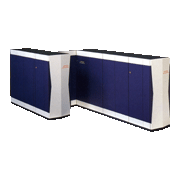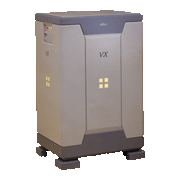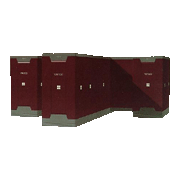The VPP500 was Fujitsu’s new “vector-parallel” supercomputer. Fujitsu announced the supercomputer in September 1992 as being the world’s fastest performing supercomputer at the time with a speed of 355 gigaFLOPS. Fujitsu arranged briefcase-sized processor units, each capable of vector processing, in parallel to obtain this performance. Fujitsu connected 222 processor units in parallel to reach 355 gigaFLOPS.
Each processor unit consisted of a processor made of gallium arsenide LSI chips and ultra-high-density circuit boards and was able to deliver a maximum vector performance of 1.6 gigaFLOPS. To reach the maximum vector performance of 355 gigaFLOPS, individual processor units were connected with a crossbar network for synchronized parallel processing. Major application fields for the VPP500 included aerospace engineering using computational fluid dynamics, weather and environmental modeling, nuclear fusion research using particle simulations, and molecular chemistry using molecular dynamics principles.
The VPP500 was jointly developed by Fujitsu and the National Aerospace Laboratory of Japan (which merged with the Japanese Aerospace Exploration Agency (JAXA) in October 2003). The VPP500’s development was based on the same technology used in the Numerical Wind Tunnel (NWT) project, which began operating in January 1993.
| Model | VPP500/7 — VPP500/222 |
|---|---|
| Introduced | September 1992 |
| No. of processors | 7 — 222 |
| Max. vector performance per processor | 1.6GFLPS |
| Max. vector performance | 11.5 — 355.2 GFLOPS |
Fujitsu announced several more vector-parallel supercomputers that took their lead from the VPP500. The Fujitsu VPP300 series and VX series, which used CMOS*1 technology, were introduced in February 1995, the Fujitsu VPP700 series in March 1996, and the VPP5000 series in April 1999. All VPP series supercomputers starting with the VPP300 series used CMOS technology. The single processing-element LINPACK*2 benchmark performance of the VPP5000 series was 1,125 megaFLOPS with 100 elements and 8,759 megaFLOPS with 1,000 elements.
- *1. CMOS: Complementary metal oxide semiconductor.
- *2. LINPACK: LINear equations software PACKage. A benchmark introduced by Jack Dongarra, a professor at the University of Tennessee, to measure the performance of a dedicated system for solving a dense system of linear equations. This benchmark was widely used not only for supercomputers but also for workstations, personal computers, and other computing systems.
| Series | VXseries | VPP300series | VPP700series |
|---|---|---|---|
| Introduced | February 1995 | March 1996 | |
| No. of PEs | 1 — 4 | 4 — 16 | 16 — 512 |
| Max. vector performance per PE | 2.2 GFLOPS | ||
| Max. vector performance | 2.2 — 8.8 GFLOPS | 8.8 — 35.2 GFLOPS | 35.2 — 1126 GFLOPS |
| Internal disk capacity | 4GB — 60GB | 4GB — 188GB | 4GB — 1916GB |
| Crossbar performance | Max. 570 MB/s between any two PEs | ||
*PE: Processing element. An elemental computer in parallel processing equipped with its own scalar unit, vector unit, main memory, and data-transfer unit.
| Introduced | April 1999 |
|---|---|
| No. of PEs | 2 — 512 |
| Max. vector performance per PE | 9.6 GFLOPS |
| Max. vector performance | 19.2 — 4915 GFLOPS |
| Crossbar performance | Max. 3.2 GB/s between any two PEs |
The specifications above were correct at the time the products were announced. Some specifications were later revised due to product upgrades.




